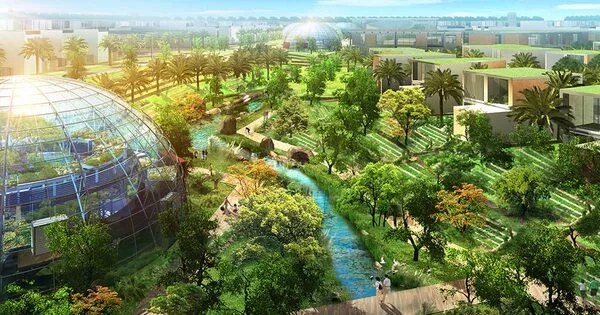The sustainable city, eco-city, or green city is a city designed with consideration for social, economic, and environmental impact (commonly referred to as the triple bottom line), as well as resilient habitat for existing populations, without jeopardizing future generations’ ability to experience the same. The purpose of a sustainable city is to meet the requirements of its current citizens without jeopardizing future generations’ ability to meet their own needs.
Sustainable cities strive to reduce their negative environmental impact while improving the quality of life for its residents. Sustainable cities are those that are committed to achieving green sustainability, social sustainability, and economic sustainability, according to UN Sustainable Development Goal 11. They are committed to achieving so through creating opportunities for all through inclusive design while maintaining long-term economic growth. The emphasis also involves limiting energy, water, and food inputs, as well as substantially lowering waste, heat output, air pollution – CO2, methane, and water pollution.
Here are some key principles and features of sustainable cities:
Environmental Sustainability:
- Efficient Resource Use: Sustainable cities strive to use resources like water, energy, and land efficiently, reducing waste and pollution.
- Renewable Energy: They promote the use of renewable energy sources such as solar, wind, and hydropower to reduce greenhouse gas emissions.
- Green Spaces: Sustainable cities prioritize green spaces, parks, and urban forests to improve air quality and provide recreational areas.
- Waste Reduction: They implement recycling programs and waste reduction strategies to minimize landfill waste.
Transportation:
- Public Transportation: Sustainable cities invest in efficient and extensive public transportation systems to reduce reliance on private cars.
- Cycling and Walking: They create bike lanes and pedestrian-friendly infrastructure to encourage non-motorized transportation.
- Electric Vehicles: Promoting the use of electric vehicles or other low-emission forms of transportation.
Urban Planning:
- Mixed-Use Development: Sustainable cities encourage mixed land-use, where residential, commercial, and recreational areas are integrated to reduce the need for long commutes.
- Compact Design: They aim for compact, dense urban development to minimize sprawl and preserve natural areas.
- Affordable Housing: Ensuring housing affordability to promote social equity and prevent urban sprawl.
Water Management:
- Efficient Water Use: Sustainable cities employ water conservation measures, such as low-flow fixtures and efficient irrigation systems.
- Stormwater Management: Implementing systems to manage and reuse stormwater to prevent flooding and reduce water pollution.
Waste Management:
- Recycling and Composting: Encouraging recycling and composting to reduce the amount of waste sent to landfills.
- Waste-to-Energy: Exploring waste-to-energy technologies to convert waste into energy.
Social Equity:
- Inclusivity: Ensuring that all residents, regardless of income or background, have access to essential services, housing, and opportunities.
- Education and Health: Providing quality education and healthcare services to promote the well-being of residents.
- Community Engagement: Involving residents in decision-making processes and sustainability initiatives to build a sense of ownership and responsibility.
Cities that are environmentally responsible are both economically viable and socially inclusive. They want to provide a high quality of life for its citizens while also protecting the environment for future generations. Sustainable urban development necessitates a multifaceted approach that includes government policy, urban planning, community engagement, and technological innovation.
















